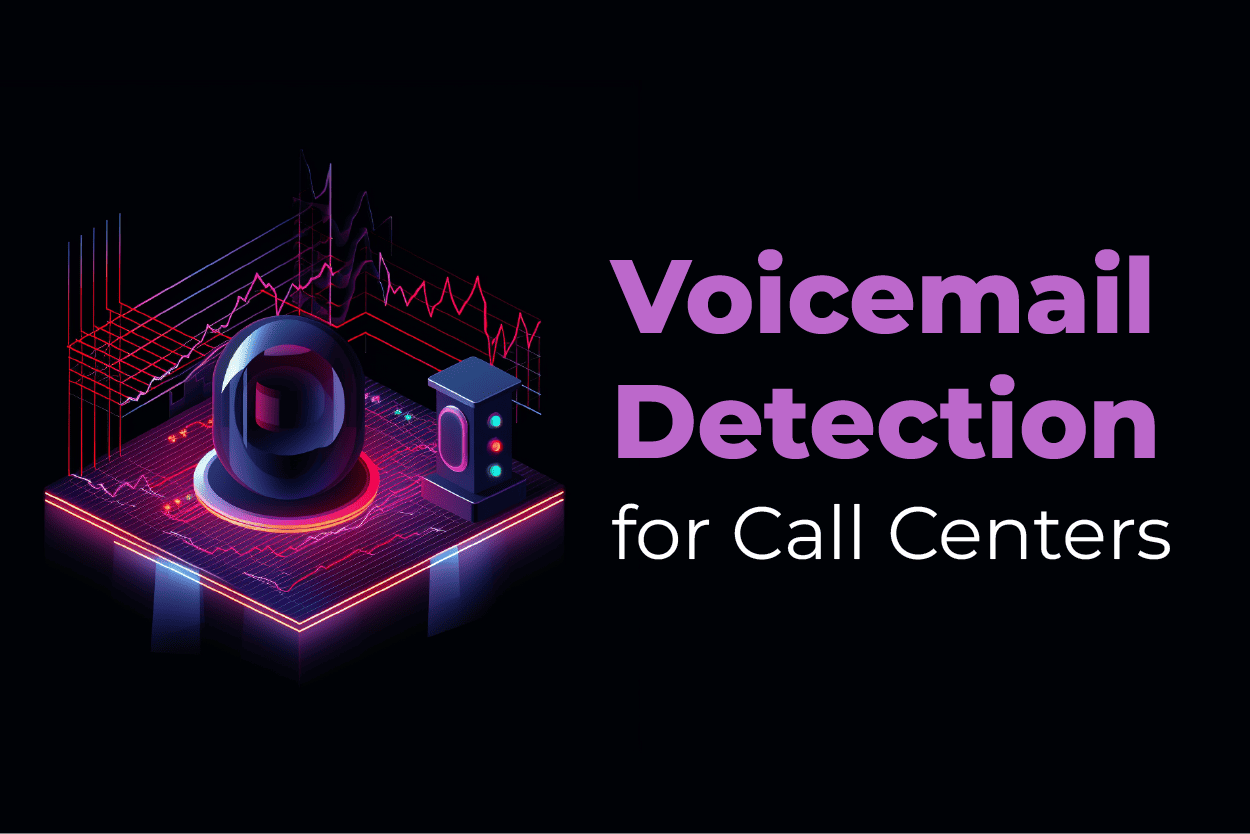Answering Machine Detection (AMD) is transforming call centers by eliminating wasted time on voicemails and ensuring agents focus on real customer conversations. With advanced algorithms and deep learning, AMD boosts efficiency, improves contact rates, enhances customer experience, and positions itself as a vital standard for the future of customer engagement.
- Efficiency Through AMD: Answering Machine Detection (AMD) reduces wasted agent time by bypassing voicemails and connecting only with live customers.
- Boosted Contact Rates: By skipping automated responses, AMD improves call success rates and maximizes customer engagement opportunities.
- Enhanced Agent Utilization: Agents spend more time in meaningful conversations, leading to greater productivity, satisfaction, and service quality.
- Advanced Technology: Deep learning and voice analytics make AMD more accurate, adapting to new voicemail-to-text and network-based services.
- Integration Roadmap: Successful AMD adoption requires strategic planning, operational recalibration, workforce training, and ongoing system evolution.
- Future Standard: AMD is rapidly becoming a gold standard in call centers, aligning technology with customer-first service and measurable business outcomes.
The call center sector, constantly under pressure to enhance customer satisfaction and operational efficiency, finds a revolutionary ally in voicemail detection. This tool, increasingly integral to modern call centers, not only optimizes outreach but also crafts a streamlined experience for both agents and clients.
What is Answering Machine Detection?
Answering Machine Detection (AMD), also known as voicemail detection, is an advanced technology crafted to differentiate between actual human responses and automated answering systems in real time. This seemingly simple differentiation is a significant step forward in the quest for efficiency in call centers.
“Answering machine detection isn’t just about technology; it’s a strategic orchestration of algorithms that distinguish the echoes of voicemails from the cadence of human conversations. It enables agents to engage where it counts, saving valuable time for genuine connections.”
– Christian Montes, Chief Operating Officer at NobelBiz
How does Answering Machine Detection Work?
Voice communications, in essence, are a confluence of frequency patterns, pitch modulations, and unique tonal properties. Answering Machine Detection (AMD) is rooted in this complex world of sound waves, built to discern subtleties and distinguish between human voices and automated recordings.
The Foundation
At its core, AMD is designed using advanced voice analytics, which assesses vocal frequencies, the presence or absence of natural voice inflections, and specific patterns common to recorded messages. Paired with these voice analytics are robust algorithms trained on large datasets of recorded voicemails and real-time human responses.
Functionality
Upon a call’s initiation, AMD begins its real-time analysis. By cross-referencing the incoming audio against its trained datasets, it swiftly identifies if the response is from a human or a voicemail. Depending on its assessment, the system then prompts the subsequent action – either connecting the call to an agent or moving on to the next number.
Outcomes
The immediate result is clear – a drastic reduction in wasted time for agents and an uptick in efficiency metrics. But, from a broader standpoint, it paves the way for better agent morale, more meaningful customer interactions, and heightened overall call center efficacy.
Clinical Trial Media
Mo Pene |
Contact Center Technology Manager @ CTM
‘Thanks to NobelBiz, we now enjoy a robust, scalable communication system tailored to our growing needs, empowering us to deliver personalized care experiences more efficiently and boosting our overall revenue.’
Key Benefits of Voicemail Detection
Contact center businesses and departments embrace voicemail detection for its indispensable role in streamlining operations and enhancing agent efficiency. By employing advanced algorithms to differentiate between live answers and voicemail recordings, this technology enables agents to focus their efforts solely on engaging with customers in real-time conversations.
This strategic implementation not only maximizes agent productivity but also improves overall customer experience by reducing wait times, eliminating unnecessary voicemail interactions, and ensuring that every interaction counts. Voicemail detection empowers contact centers to allocate resources judiciously, aligning their operations with the twin goals of operational optimization and delivering personalized, meaningful customer interactions.
Let’s look at some of the key benefits of answering machine detection.
Augmented Customer Journeys
The ripple effect of a single negative customer experience can be far-reaching, with the potential to tarnish a brand’s reputation. AMD addresses a significant pain point in this journey—irrelevant voicemail messages.
The AMD Advantage:
With the precision offered by AMD, call centers have the capability to circumvent this issue entirely. By ensuring that customers are contacted directly and timely, call centers can craft personalized and valuable interactions that contribute to long-lasting client relationships.
Skyrocketing Contact Rates:
Answering machine detection can really shake things up when it comes to a contact center’s contact rate. Imagine this: by pinpointing voicemail systems and skipping those calls, answering machine detection slashes the time agents waste on dead-end conversations. Instead, they’re plugged into real, live chats with customers more often. This turbocharges the contact rate – agents are steering clear of voicemails and diving straight into the real stuff. The outcome? Efficiency soars, agents aren’t stuck navigating voicemail mazes, and the contact center can handle a whole bunch more productive chats. It’s like giving the contact rate a booster shot, all thanks to smarter call routing.
Operational Impact:
This heightened success rate means more opportunities for agents to address customer queries, resolve issues, and drive sales, ultimately boosting the bottom line.
Enhanced Agent Utilization
An agent’s time is invaluable. Ensuring they’re engaged in meaningful, result-driven interactions is pivotal to both their job satisfaction and the center’s overall success.
Operational Ramifications:
The direct consequence of this is two-fold. Firstly, agents spend significantly less time navigating through voicemails, which can often be a draining and unproductive endeavor. Secondly, with more active talk time, they’re better positioned to understand, engage with, and cater to customer needs, elevating the overall quality of service.
“In the intricate web of contact center dynamics, answering machine detection assumes the role of an automated guide, expertly steering agents away from voicemails and towards real-time conversations. It’s a technological sentinel that optimizes every connection we establish.”-
– Mike Mcguire, Chief Revenue Officer at NobleBiz
AMD Integration: A Roadmap for Call Centers
Embracing AMD is not merely about integrating a new tool. It’s about recalibrating operations, training the workforce, and maintaining an edge in the ever-evolving technological landscape.
When we talk about AMD integration, we're venturing into a multi-faceted realm that blends technology, people, and processes. It’s not just about embedding a new tool into an existing framework; it’s a paradigm shift that requires strategic planning, adept execution, and continuous evolution.
1. Strategic Vision and Planning
Before AMD can be incorporated, there must be clarity in vision and purpose. Call centers need to:
Assess Current Needs:
Pinpoint areas where efficiency is lagging, and identify bottlenecks that AMD could potentially address.
Set Clear Objectives:
What do you hope to achieve with AMD? Whether it’s a reduction in call wait times, improved agent efficiency, or enhanced customer experience, having clear objectives will guide the integration process.
Evaluate Potential Partners:
Not all AMD solutions are created equal. Select a provider whose technology aligns with your specific needs, offers robust support, and has a proven track record in the industry.
2. Operational Recalibration
The introduction of AMD requires systemic recalibration. This means:
Streamlining Call Processes:
Integrating AMD may necessitate redefining how calls are queued, routed, and handled. This might involve creating new workflows or adjusting existing ones to leverage the capabilities of AMD fully.
Infrastructure Overhaul:
Ensure that the existing IT infrastructure can support AMD. This might involve upgrading hardware, enhancing network capabilities, or integrating other complementary technologies.
Policy Refinement:
With AMD, certain call handling protocols might need revisiting. For instance, policies about call retries or how to handle detected voicemails may need fine-tuning to optimize outcomes.
3. Workforce Training and Adaptation
The success of any technological solution rests not just on the technology itself, but also on the people using it. Thus, a holistic approach to AMD integration includes:
Comprehensive Training:
Equip agents with the knowledge and skills to harness AMD's capabilities. This includes understanding how AMD works, interpreting its signals, and adapting their approach based on the information it provides.
Feedback Loops:
Establish mechanisms for agents to provide feedback on AMD's performance. This will aid in identifying any teething issues and refining the system for optimal results.
Performance Metrics:
Introduce or modify KPIs to track and measure the impact of AMD on agent performance and call center outcomes. This could encompass metrics like 'Calls Successfully Connected vs. Detected Voicemails' or 'Agent Talk Time Post-AMD Integration'.
4. Continuous Evolution in a Dynamic Landscape
The tech landscape is fluid, and to maintain an edge, call centers must:
Stay Abreast of Advancements:
The world of AMD will not remain static. New advancements, updates, and features will emerge. Call centers must have a pulse on these changes to ensure their AMD solutions remain top-tier.
Regular System Reviews:
Periodically assess the AMD system's performance. This will help in identifying areas for improvement and ensuring that the system aligns with the call center's evolving needs.
Engage in Industry Dialogues:
Participate in forums, conventions, and seminars focused on voicemail detection technology. Such engagements offer insights into best practices, challenges faced by peers, and potential solutions.
“Answering machine detection isn’t just about technology; it’s a strategic orchestration of algorithms that distinguish the echoes of voicemails from the cadence of human conversations.”-
– Mike Mcguire, Chief Sales Officer at NobleBiz
Latest Developments in Answering Machine Detection Technology
One of the significant challenges call centers often grapple with is the ability to reach their intended recipients efficiently.
As we have seen, Answering Machine Detection (AMD) holds the potential to boost call center efficiency and productivity by trimming the time spent on managing voicemails or crafting pre-recorded messages. However, AMD doesn’t come without its share of concerns and potential issues for consumers, encompassing privacy, accuracy, and adherence to regulations.
AI and Deep Learning Accuracy
Recent strides in AMD technology highlight the integration of deep learning techniques to enhance detection accuracy and speed. Models now analyze pitch, energy, silences, and speech recognition in real time. A 2024 study pairing YAMNet with RNN reported over 96% accuracy, improving to 98% when paired with silence detection.
Language-Independent AMD
In 2025, language-agnostic AMD models are gaining adoption, enabling global contact centers to operate seamlessly across accents and regions without separate tuning. This marks a shift away from older DSP-based pipelines that struggled with multilingual accuracy.
Real-World Efficiency Gains
Modern call platforms in 2025 report up to 40% improved agent efficiency and 25% higher live connection rates using optimized AMD pipelines with advanced inference settings.
Compliance and Evolving Standards
These technological advances are arriving alongside more sophisticated compliance frameworks and privacy standards. With real-time classification now operating in under two seconds and nearing 100% accuracy, AMD systems align better with regulatory scrutiny and consumer protections. Read more on DestinationCRM.
Salman Aslam
Director Support – Quality & Training at WORK Inc.
‘The support team at Nobelbiz understood our business requirements and we we’re able to push through seamlessly’
Boost Your Productivity with the AMD System of NobelBiz OMNI+
Elevate your contact center experience with the power of NobelBiz OMNI+ . Our advanced Answering Machine Detection (AMD) seamlessly integrates into our cloud contact center software, revolutionizing how you connect with customers. With AMD as an integral part of our solution, you’ll unlock the potential for increased agent efficiency and meaningful interactions. Say goodbye to wasted resources and hello to a future where every conversation counts.
FAQs About Answering Machine Detection
Discover how NobelBiz helps call centers maximize customer engagement, boost answer rates, and ensure compliance with industry-leading solutions.

Michael McGuire is a contact center industry expert with almost two decades of experience in the space. His experience includes roles as Director of Contact Center Digital Transformation at NobelBiz, and as Director of Operations at FLS Connect, managing multiple call centers. As President of Anomaly Squared and Targeted Metrics, Michael successfully transitioned companies into remote operations and significantly boosted revenues. With a strong background in customer service, leadership, strategic planning, and operations management, Michael excels in driving growth and innovation in the call center space.
Mike is also a proud Board Member for R.E.A.C.H Trade Group, promoting consumer protection and satisfaction and Co-host of the Off Skripted Podcast – a show about Life, Call Centers and everything in between.









